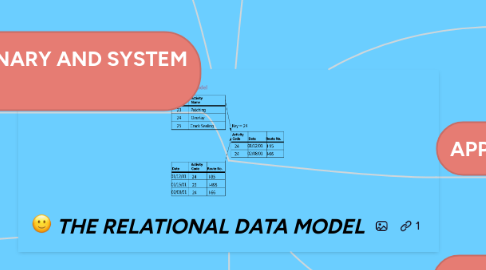
1. KEYS
1.1. COMPOSITE KEY
1.1.1. COMPOSITE OF MORE THAN ONE ATTRIBUTE
1.2. KEY ATTRIBUTE
1.2.1. ANY ATTRIBUTE THAT IS PART OF A KEY
1.3. SUPERKEY
1.3.1. ANY KEY THAT UNIQUELY IDENTIFY EACH ROW
1.4. CANDIDATE KEY
1.4.1. A SUPERKEY WITHOUT UNNECESSARY ATTRIBUTE
1.5. FOREIGN KEY
1.5.1. AN ATTRIBUTE WHOSE VALUES MATCH PRIMARY KEY VALUES IN THE RELATED TABLE
1.6. REFERENTIAL INTEGRITY
1.6.1. fk CONTAINS A VALUE THAT REFERS TO AN EXISTING VALID TUPLE (ROW) IN ANOTHER RELATION
1.7. SECONDARY KEY
1.7.1. KEY USED STRICTLY FOR DATA RETRIEVAL PURPOSE
2. INDEXES
2.1. INDEX KEY
2.1.1. index's reference point
2.1.2. points of data location identified by the key
2.2. UNIQUE INDEX
2.2.1. index in which the index key can have only one pointer value (row) associated with it
3. DATA DICTIONARY AND SYSTEM CATALOG
3.1. DATA DICTIONARY
3.1.1. provides details accounting of all tables found within the user/designer-created database
3.1.2. contain (at least) all the attributes names and characteristics for each table in the system
3.1.3. contain meta data
3.2. SYSTEM CATALOG
3.2.1. the detailed system data dictionary that describes all objects with the database
4. INTEGRITY RULES
4.1. many RDBMs enforce integrity rules automatically
4.2. safer to ensure application design conforms to entity and referential integrity rules
4.3. designers use flags to avoid nulls
5. RELATIONAL MODEL
5.1. relational data management system (RDBMS)
5.1.1. performs same functional provided by hierarchical model
5.1.2. hides complexity from the user
5.2. relational diagram
5.2.1. representation of entities,attributes and relationships
